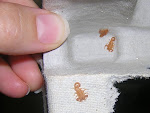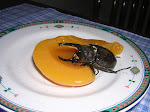You may have seen a collection of amazing insect photographs recently on flicker, all of them taken by zoologist Dr. Arthur Anker from Kyrgyzstan while in Gran Sabana region of Venezuela's Canaima National Park. The photos are not new, but popular media's discovery of them is. Several of the more amazing photos in the flicker collection are of moths. One covered in thick white hairs, or "setae", has been popularized as the "poodle moth". One journalist ventured to extend that title to a male "bulldog moth" since it looked so badass (my word, not his).
In truth, the poodle moth shown is a male. Many moth species can be easily sexed by the antennae; males often have plumose antennae, which are often larger and quite breathtaking, while the antennae of females are comparably more slender with less surface area. The larger antennae surface area of male moths allows them to detect females by their scent, packing in countless chemo-receptive molecules throughout the antennae to pick up the faintest trace of a female in the wind. ...Perhaps a more apt canine counterpart to a male moth would be the bloodhound.
Anyway, the photos are pretty neat and you won't regret checking them out. I'm particularly fond of the red and white moth (a Santa Claus moth!). While butterflies get a lot of attention, and certainly dominate most genres of insect art, much to my displeasure, it is their cousin, the moth, whose form and function I've always found fascinating. As adults, many of them are creatures of the night, colorful or cryptic, their behavior brilliantly elusive. As caterpillars, some are so large and adept at using their "horns" as to elicit shudders from even seasoned entomologists (e.g., the hickory horned devil or white-lined sphinx, among many others). Moths are, in short, pretty darn badass.
Sunday, September 2, 2012
Subscribe to:
Post Comments (Atom)
+reduced.jpg)


No comments:
Post a Comment